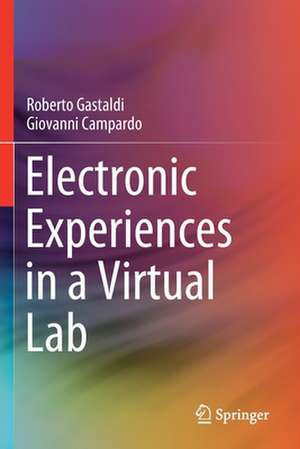Electronic Experiences in a Virtual Lab
Autor Roberto Gastaldi, Giovanni Campardoen Limba Engleză Paperback – 12 mai 2021
| Toate formatele și edițiile | Preț | Express |
|---|---|---|
| Paperback (1) | 637.59 lei 6-8 săpt. | |
| Springer International Publishing – 12 mai 2021 | 637.59 lei 6-8 săpt. | |
| Hardback (1) | 643.84 lei 6-8 săpt. | |
| Springer International Publishing – 12 mai 2020 | 643.84 lei 6-8 săpt. |
Preț: 637.59 lei
Preț vechi: 750.11 lei
-15% Nou
Puncte Express: 956
Preț estimativ în valută:
122.02€ • 126.05$ • 101.55£
122.02€ • 126.05$ • 101.55£
Carte tipărită la comandă
Livrare economică 26 martie-09 aprilie
Preluare comenzi: 021 569.72.76
Specificații
ISBN-13: 9783030451813
ISBN-10: 303045181X
Ilustrații: XVII, 218 p. 260 illus., 239 illus. in color.
Dimensiuni: 155 x 235 mm
Greutate: 0.34 kg
Ediția:1st ed. 2020
Editura: Springer International Publishing
Colecția Springer
Locul publicării:Cham, Switzerland
ISBN-10: 303045181X
Ilustrații: XVII, 218 p. 260 illus., 239 illus. in color.
Dimensiuni: 155 x 235 mm
Greutate: 0.34 kg
Ediția:1st ed. 2020
Editura: Springer International Publishing
Colecția Springer
Locul publicării:Cham, Switzerland
Cuprins
Electronic theory fundamentals.- Power Supplies.- Amplifiers.- An example: sound equalizer using an operational amplifier.- Simple logic circuits.- Oscillators.- Something more complex.- Simulation of active devices characteristics.- Fundamentals of Spice operation.
Notă biografică
Giovanni Campardo was born in Bergamo, Italy, in 1958. He received the Laurea degree in Nuclear Engineering from the Politecnico of Milan in 1984. In 1997 he graduated in Physics from the Università Statale di Milano. He deals with microelectronics, today in an Italian-French company, in particular in the field of non-volatile solid state memories. He is author-co-author of many publications and some books and hold more than 100 patents. He is married with two children and enjoys painting and reading. He collects ethnic masks from the entire world and practice Chinese martial arts.
Roberto Gastaldi holds a Master degree in Electronic Engineering from Politecnico di Milano Italy. He has been working for over thirty years in a semiconductor manufacturing corporation as a non-volatile memory designer. During his career he led the design of many successful memory chips as well as first prototypes for leading edge memory technologies. Mr. Gastaldi holds several papers and patents related to VLSI memory design and technology, he is a member of IEEE.
Roberto Gastaldi holds a Master degree in Electronic Engineering from Politecnico di Milano Italy. He has been working for over thirty years in a semiconductor manufacturing corporation as a non-volatile memory designer. During his career he led the design of many successful memory chips as well as first prototypes for leading edge memory technologies. Mr. Gastaldi holds several papers and patents related to VLSI memory design and technology, he is a member of IEEE.
Textul de pe ultima copertă
This book presents a collection of “lessons” on various topics commonly encountered in electronic circuit design, including some basic circuits and some complex electronic circuits, which it uses as vehicles to explain the basic circuits they are composed of. The circuits considered include a linear amplifier, oscillators, counters, a digital clock, power supplies, a heartbeat detector, a sound equalizer, an audio power amplifier and a radio. The theoretical analysis has been deliberately kept to a minimum, in order to dedicate more time to a “learning by doing” approach, which, after a brief review of the theory, readers are encouraged to use directly with a simulator tool to examine the operation of circuits in a “virtual laboratory.” Though the book is not a theory textbook, readers should be familiar with the basic principles of electronic design, and with spice-like simulation tools. To help with the latter aspect, one chapter is dedicated to the basic functions and commands of the OrCad P-spice simulator used for the experiments described in the book.
Caracteristici
Introduces readers to electronic circuits, how to design them in the lab, and how to simulate them Shows in detail how to simulate electronic circuits using OrCad Offers several examples such as a clock circuit, amplifiers and a shift register
